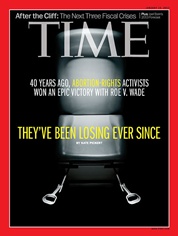
In the article, Pickert says there is a rebellion going on within the abortion rights cause, pitting younger feminists against the old-time leaders who were in their 20’s and 30’s when the battle began with Roe. But now, she says, these leaders are out of touch with the problem of state laws that curtail abortion while polls are showing abortion acceptance dwindling. The younger women want to take control of the fight, and believe they can do better than the old guard.
Pickert claims that this rebellion pitting feminists against feminists is tearing the movement apart at the very time state laws are eroding access to abortion, and that this power grab within the movement has come at a time when public opinion is turning against abortion. The elderly leadership, young pro-choice advocates say, cannot solicit young people to get involved in the battle to keep abortion legal. They think they can.
On the state level in particular, pro-abortion forces are unequivocally losing. And from the standpoint of public opinion, only 41% want to be identified as “pro-choice.”
A Gallup poll shows that the majority of Americans support restriction such as waiting periods and parental consent laws. The author says that as public opinion changes, abortion access will continue to erode. She says the fight to preserve access to abortion is more daunting than was the fight to legalize it.
State laws that limit abortion are abounding. In 2011, 92 abortion regulations were passed in 24 states. In each of four states, there is only one abortion facility: North Dakota, South Dakota, Mississippi, and Arkansas. The total number of abortion providers have dwindled from 2, 908 in 1982 to 1,793 in 2008. Abortion providers and abortion supporters also fear that bills granting “personhood’ to the unborn — the ultimate goal of many pro-lifers — will get a case to the U. S. Supreme Court, which would directly challenge the constitutionality of Roe v. Wade. Until then, the state laws just keep coming.
Among other state regulations cutting into abortions are laws requiring doctors to have hospital admitting privileges, and the ability of pro-life activists to dissuade women from having abortions through sidewalk counseling. Pro-lifers also take every opportunity to and celebrate the closing of abortion clinics.
Pickert returns inevitably to the problem of new and younger leadership, who even want to drop the outdated term “pro-choice.” They want to substitute “reproductive justice” to cover a larger agenda including contraception, gay rights, health insurance, and child care. They say younger women connect with such a “holistic” concept.
But not only have today’s abortion supporters had to fight laws against abortion. They also have to face the reality that many women who have abortions do not wholeheartedly support abortion, but have abortions they sooner or later regret. Pickert says many comments written in the logs in the abortion clinics are extremely negative.
Meanwhile, the pro-life cause is aided by scientific advances, the use of ultrasound technology see the baby in the womb, and knowledge of the humanity of the developing child. It is hard to sell abortion on the distorted argument that it’s just another medical procedure. Much of the public knows better.
Finally, available abortionists are dwindling, and not only does the number of abortions go down, but with so few doing abortions there is a stigma that the abortionists deplore. In 1981, 30 women per thousand had abortions. In 2008 it was down to 20 per thousand.
The overall theme of Pickert’s article is clear: while the abortion activists won an epic victory in Roe v. Wade, they’ve been losing ever since.
